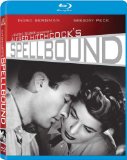| Reviews & Columns |
|
Reviews DVD TV on DVD Blu-ray 4K UHD International DVDs In Theaters Reviews by Studio Video Games Features Collector Series DVDs Easter Egg Database Interviews DVD Talk Radio Feature Articles Columns Anime Talk DVD Savant Horror DVDs The M.O.D. Squad Art House HD Talk Silent DVD
|
DVD Talk Forum |
|
|
| Resources |
|
DVD Price Search Customer Service #'s RCE Info Links |
|
Columns
|
|
|
Spellbound (1945)
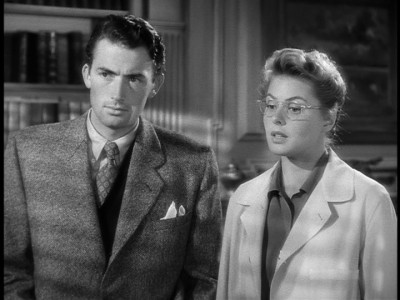
Please Note: The screen captures used here are taken from the 2002 standard-definition DVD edition, not the Blu-ray edition under review.
1945's Spellbound is the second of three full-on collaborations between cinematic-genius director Alfred Hitchcock and his star Hollywood producer, Gone With the Wind mastermind David O. Selznick (whose contractual relationship with the British expat had him playing a more minor role in a handful of other Hitchcock films of the period that he didn't actually produce). Their partnership ended on a minor note in 1947 with The Paradine Case, and it was always a tug-of-war for creative control, but their first meeting of the minds was immortally combustible, resulting in the glorious Rebecca, an enduringly wonderful film that was a more than worthy American debut for Hitchcock. And the silkily elegant, well-appointed Spellbound, with its glamorous stars Ingrid Bergman and Gregory Peck and its dream-sequence contribution from Salvador Dali (probably the main reason the film can be counted among Hitchcock's better-known efforts), is in turn an apt-enough follow-up to Rebecca. It's not quite the tour de force that that film remains (and none of Hitchcock's more Hollywood-ized Selznick pictures approach the greatness of 1943's Shadow of a Doubt, let alone the string of towering, subversively modernist-cool masterworks to come in the '50s and '60s), but Spellbound is still quite the treat to rewatch for the second or third or tenth time, offering as it does the alluring melting-together of Hitchcock's flair for the eerie, the suspenseful, and the psychosexual with the lusher, prettier, more indulgently romantic Selznick touch.
With a screenplay by consummate studio-era movie scribe Ben Hecht, Spellbound tells a story that's no less appealing and engaging for being blatantly dimestore-Freud reductive in its presentation of psychoanalytical ideas. A title explaining the concept that comes up before the film proper begins informs us that "[In psychoanalysis], once the complexes that have been disturbing the patient are uncovered and interpreted, the illness and confusion disappear.....and the devils of unreason are driven from the human soul," which one cannot help imagining Hitchcock, infinitely more sophisticated and wisely pessimistic than that about the human soul's devils of unreason, having a hearty giggle over. More ironically-minded viewers may even wonder if this declamation is deadpan, something made purposely too-pat in order to then be slyly poked fun at through the awakening and unbuttoning of a tidily cerebral psychoanalyst that transpires in the film. But what helps put this Pollyanna conception of psychoanalysis over is that it's so blatantly a pretext (you could call the whole subject of psychoanalysis Spellbound's real MacGuffin) used to bring about the inevitable union of the film's stars, Ingrid Bergman--who plays Constance Petersen, a psychoanalyst in residence at a country estate/asylum called Green Manors--and Gregory Peck.
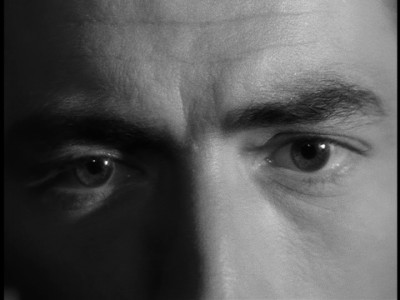
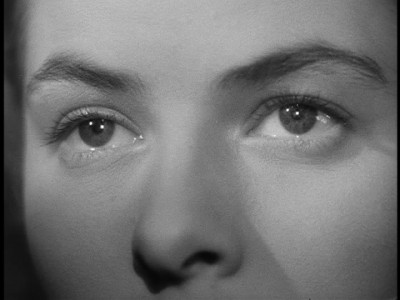
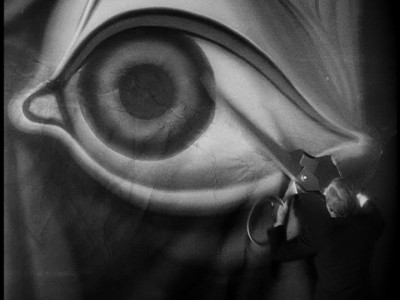
The clues as to who this man is, what he really saw when the real Dr. Edwardes died, and who, if not him, the real murderer is, lie in a dream. This dream is shown to us in a famous sequence designed by Salvador Dali, which is undoubtedly the single best-remembered piece of the film, and rightly so; it's a thing of great beauty on purely visual/cinematic terms, and its inventively shot surrealism holds the key not only to the film's plot, but also to its entire irrational, anti-"realistic" style and sensibility. The exaggerations and strange points of view of the dream as it plays out--for example, the giant scissors slicing up eyeballs that hark back to Dali's own notorious 1929 cinematic foray, Un Chien andalou, or the smooth track towards a mysterious figure across a bizarrely vast tabletop from the point of view of a hand dealing huge playing cards--bear a relation to the rest of the film through which it is made that much easier for us to suspend our disbelief and go along with its relatively irrational, "dream" logic. Its disconcerting visual pleasures also remind us that the medium of cinema itself is the one most uniquely apt for telling stories that look and feel like dreams; one can easily imagine that David Lynch--the last major filmmaker to try marrying reflexively, spasmodically anti-rational surrealism to the supposed logic demanded by narrative, reaping great artistic rewards from the irresolvable tension between the two modes--took some courage from Hitchcock and Dali's odd but exhilarating Hollywood/avant-garde hybrid. (The eyes really do have it; the dream sequence's looming eyeballs rhyme not only with Dali's earlier movie imagery, but more intratextually with the half-seductive, half-violating, uncannily close-up Peck/Bergman shot/reverse-shot meetings of the eyes elsewhere in the film, which I feel certain are echoed in the near-identical moment played out between Laura Harring and Naomi Watts in Lynch's Mulholland Drive.)
The less spectacularly unusual of Hitchcock's collaborators here--in particular cinematographer George Barnes, editor Hal Kern (both of whom also worked on Rebecca), and composer Rosza--are less showily but more consistently important than Dali, all doing their part to help the master create a film that, like Rebecca, maps out a territory where his more typical, cooler detachment and all the lush Selznickian extravagance can meet and gel. Beyond the requisite, classically gorgeous, soft-lit close-ups of Bergman that are inserted for no better reason (and none is needed) than that it's, you know, Ingrid Bergman, some of the film's camera/editing moves (the aforementioned eye-to-eye close-ups, the lateral-tracking swoops in on Peck as he recounts his dream, a panning shot taken from the point of view of a revolver aimed at Bergman) are at once perfectly subsumed to the film's purposes and the most delicious iterations of the kind of pure cinematic craftsmanship that is the mark of classical studio filmmaking at its very best. The entire Hitchcock filmography is, of course, an embarrassment of these kinds of riches, and in the final analysis Spellbound belongs to the "lighter," less profound and perfect side of his œuvre, and would even have to be considered the junior member of Hitchcock's Bergman duo (the other being the darker, smoother, more symmetrical Notorious). But such distinctions between approaching greatness and being "merely" a finely wrought and uniquely evocative entertainment that falls short of greatness don't seem all that urgent when it comes to evaluating a well-polished, eternally enjoyable gem like Spellbound; the many ways in which its artistry gives pleasure shouldn't be discounted just because they'll never have their way with you and ruin you for other movies like Vertigo does. Certainly, Spellbound is in a lower, less ambitious gear than the films for the ages that Hitchcock made more than his share of, but it also has its own strange energy, an odd mixture of cinematic ingredients boiled up together in a uniquely enjoyable brew that can always be counted on to leave you simultaneously on the edge of your seat and swooning in a particularly gratifying ratio that you just can't quite replicate anywhere else.
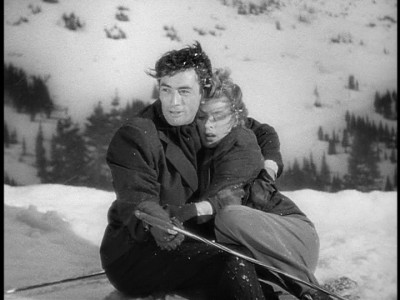
THE BLU-RAY DISC:
The 1080/24p, AVC/MPEG-4, 1.37:1 aspect-ratio transfer offers consistently superb image quality. There was no aliasing or edge enhancement that I could discern, and flicker is kept to a bare minimum (the images and their movements are likely nearly as pristine as the original, brand-new prints when you take the technological/photographic limitations of the time into account). Best of all, the fine celluloid texture of the film has not been digital-noise-reduced away, so every frame looks and feels like an actual movie. The film was clearly meant to be a treat for the eye if nothing else, and this transfer does an all-around excellent job of keeping it that way on the home screen.
Sound:Every copy of Spellbound that I've ever seen has stretches of sonic discrepancy wherein the dialogue seems to have been mixed very, very low and Rosza's score is very, very high, leaving you straining to hear what a character is saying one moment and jarred by a suddenly blaring eruption of music the next. That seems to be an innate property of the film itself (which probably didn't make as much of a difference when it was shown in theaters), and it's not entirely remedied here, but the disc's DTS-HD Master Audio 2.0 mono soundtrack does seem to be a bit better balanced than previous versions, with some further clarity in both dialogue and music. There are still, however ,some perhaps unavoidably fuzzy, buried bits of dialogue and distortions in the sound at particularly loud moments. I found that the best strategy was to play the film louder rather than softer, and just be prepared for the lurch (and the way the music is used, it may have been intended that way, as a shock to give an extra thrill to more suspenseful moments) from audible-conversation volume to auditorium-strength sound when the music comes up.
Extras:--A feature-length audio commentary features the tag-teaming expertise of film professors Thomas Schatz and Charles Ramirez Berg as they alternate between offering exegeses and technical analysis of scenes as they go by and going into external details that run the gamut from the significant (the guilt complex of David O. Selznick after his brother's death; the fact that both Selznick and Ben Hecht, Spellbound's screenwriter, were in psychoanalysis themselves during the time preceding the project) to the divertingly trivial (a serious discussion of the score's important role digresses momentarily for a comment on how Rozsa was the first to bring the then new-fangled "spooky" sound of the theremin to Hollywood movie music). It's not the deepest or most incisive commentary I've ever heard, and the two tend to interrupt and talk over each other a bit too much, but they're affable and sufficiently knowledgeable personalities, and their input makes for an enjoyable and quite enlightening time in terms of both context for and analysis of the film.
--The 20-minute mini-documentary "Dreaming With Scissors: Hitchcock, Surrealism, and Salvador Dali" goes up-close and in-depth for a look at the collaboration of Hitchcock and Dali (and, to a great if unacknowledged extent, producer David O. Selznick and cameraman William Menzies) on the film's famous dream sequences. A well-selected group of experts on Dali (author Elliott H. King, curator Sara Cochran), Hitchcock (authors Lesley Brill and Leonard Leff) and the cinema (Biographical Dictionary of Film author David Thomson, Peter Bogdanovich) weighs in for an amazingly well-rounded and thorough rundown of how the collaboration came to be and the ultimately very involved, tricky, and fatiguing business of actually pulling it off, with lots of background on Dali's work and its relation to Surrealism, as well as his keeness for the cinema, thrown in for good measure.
--"Guilt by Association: Psychoanalyzing Spellbound", another 20-minute piece, brings back some of the experts from "Dreaming with Scissors" and rounds up a whole new slew of commentators--psychotherapy specialists Don Catherall and Jean Brown, writers Raymond Benson and Rudy Behlner, cinematographer Nance Jordan, etc.-- to discuss the theme of psychoanalysis and its treatment in Spellbound, allegedly one of the first films to explicitly be "about" the theory rather than just making use of it to explain characters' behavior. Many of the experts tell us what we already know--the film's ideas about psychoanalysis have been simplified and dramatized into something that cannot and should not be taken too seriously--but their commentary on Spellbound's currency in the wake of so many traumatized soldiers coming back from WWII and finding themselves on the couch relating their nightmares does shed some fascinatingly revealing light on a theme whose immediate relevance made the film resonate with its moment in a way that requires the historical context to see clearly--a context that this supplement does an excellent job of providing.
--"A Cinderella Story: Rhonda Fleming" is a 10-minute look back with the actress, who played the first character we're confronted with in Spellbound: a memorably disturbed, book-throwing nymphomaniac patient of Bergman's character that offers an example of the un-physical, un-erotic doctor's opposite extreme for contrast. Fleming reminisces about how she, a singer who never intended to act, was cast in the film, which is a story to rival that legend about Lana Turner's discovery at a drugstore. With lots of behind-the-scenes stills of Fleming, Hitchcock, Bergman, and Peck.
--The March 8, 1948, hour-long Lux Radio Theatre version of Spellbound, directed by Hitchcock and starring Joseph Cotten (in the Peck role) and the Italian actress Alido Valli (who would star in Hitchcock's Paradine Case and here plays the Bergman part), accompanied by a studio orchestra reprising Miklos Rozsa's score.
--A 15-minute audio interview with Hitchcock conducted by the young Peter Bogdanovich, in which the then-aspiring future Last Picture Show director queries Hitch about directing Ingrid Bergman, collaborating with Dali, and the film's then-unusual taking of psychoanalysis beyond the subtext and explicitly into the story (as well as the criticism that move came in for by those who couldn't accept its simplification of psychoanalytic theory for the masses).
--The film's original theatrical trailer, with a chattering, hyperbolic narrator and excited, exclamatory titles popping up all over the place. It's amusingly old-fashioned but actually inarguable; who's going to deny that Peck and Bergman are "an incomparable combination!" that will "hold you irresistibly...Spellbound"?
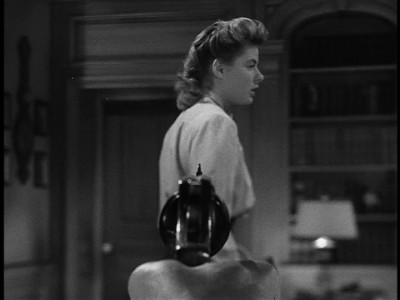
Less a pure Hitchcockian thriller than the intriguing and satisfying foray of Hitch's own subconscious-penetrating preoccupations and sensibilities into the dreamlands of surrealism and Hollywood, Spellbound isn't the master's greatest film, but there are very few pictures quite like it, either in his filmography or anywhere else. Ingrid Bergman and Gregory Peck traverse the film's tangled web of pseudo-psychoanalysis, murder-mystery, unsublimated desire, and hyper-besotted love with a glamorous, romantic, and sexy aplomb, the fire-and-ice meeting of body and soul that their characters experience matched in fascination and ravishment by the film as a whole, with its fruitful clash of the same contradictory temperaments in the implacably cool/detached Hitchcock and his consummate-showman producer, David O. Selznick. Like Bergman's initially stuffy character, we may come to Spellbound skeptical of the fast and loose, only-in-the-movies way it (mis)represents psychoanalysis, or of its swooning romantic indulgences. But like the mysterious, dapper, seductive part that Peck plays, the film makes us abandon such fustiness as it pulls us into its vortex of eerie secrets with its abundant charm and irresistibly handsome look, and we fall in love with it in spite of ourselves. Highly Recommended.
|
| Popular Reviews |
| Sponsored Links |
|
|
| Sponsored Links |
|
|
| Release List | Reviews | Shop | Newsletter | Forum | DVD Giveaways | Blu-Ray | Advertise |
|
Copyright 2024 DVDTalk.com All Rights Reserved. Legal Info, Privacy Policy, Terms of Use,
Manage Preferences,
Your Privacy Choices | |||||||









